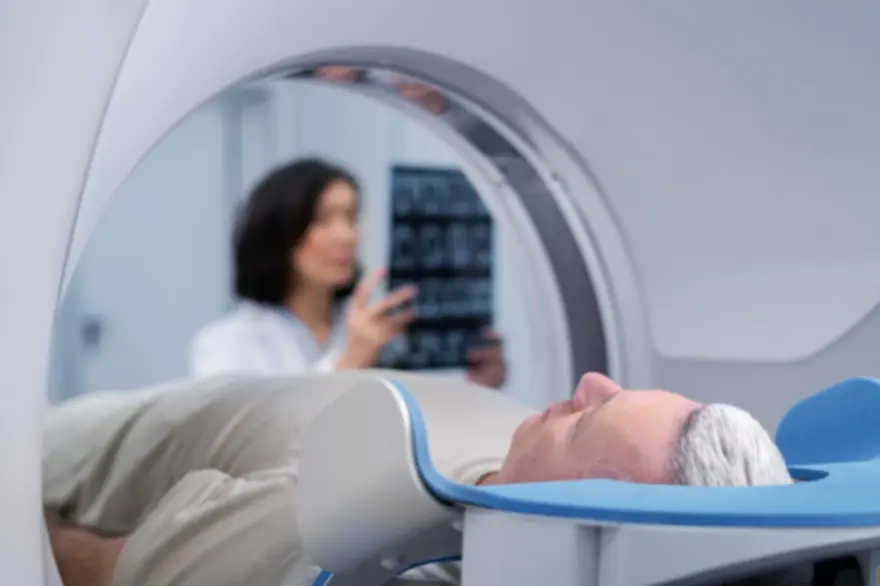Microcytic Hypochromic Anaemia Test
Microcytic Hypochromic Anaemia Test Overview
The microcytic hypochromic anaemia test, or hypochromic cells blood test, is a comprehensive diagnostic tool that helps identify and characterise a specific type of anaemia in which red blood cells are smaller than normal (microcytic) and contain less haemoglobin than usual (hypochromic). This condition is often indicated by low values of mean corpuscular volume (MCV) and mean corpuscular haemoglobin concentration (MCHC) in a complete blood count (CBC) test. The hypochromic microcytic anaemia blood test provides valuable insights into the underlying causes of this type of anaemia.
This profile includes CBC, Iron studies, StFR, Ferritin.
Microcytic anemia is a type of anemia characterized by the presence of small red blood cells (RBCs), which are called microcytes. The term "microcytic" refers to the size of the RBCs, which are smaller than normal. Hypochromic refers to the color of the RBCs, which are paler than normal.
A microcytic hypochromic anemia profile typically includes a complete blood count (CBC) test, as well as tests to measure the levels of iron, ferritin, and transferrin in the blood.
Iron-deficiency anemia is a common cause of microcytic hypochromic anemia. When iron levels are low, the body cannot produce enough hemoglobin, a protein in RBCs that carries oxygen to the body's tissues. This results in less oxygen getting to the body's cells, which can cause fatigue, weakness, and other symptoms. Other common causes include genetic disorder such as Thalassemia, chronic disease, inflammatory conditions, and chronic bleeding.
If the tests reveal a Microcytic Hypochromic Anemia, a medical professional will typically recommend further investigation to determine the underlying cause. Treatment will depend on the cause, but may include iron supplements, medications to stop bleeding and/or bone marrow examination.
Associated Tests:
A0442 Anaemia Profile-Mini
A0441 Anaemia Profile-Maxi
A0440 Anaemia Profile-Haemolytic Type
A0585 Anaemia Profile - Macrocytic
A0586 Anaemia Profile - Microcytic Hypochromic
A0443 Anaemia Profile-Nutritional
A0444 Anaemia Profile-Pernicious
A0587 Anaemia Workup Profile
Written by : Supriya Kulkarni, Lead-Content & Training
Reviewed by : Dr. Alap Christry M.D. AVP-Lab Operations & Scientific Business Head-Clinical Chemistry
Reasons for Undergoing the Microcytic Hypochromic Anaemia Test
There are several reasons why your doctor may recommend the hypochromic cells blood test:
- Symptoms of Anaemia: If you experience symptoms like fatigue, weakness, pale skin, or shortness of breath, which may indicate anaemia.
- Routine Health Check-up: As part of a general health assessment, especially if you have a family history of anaemia or related conditions.
- Monitoring Existing Conditions: If you have been diagnosed with a condition that can cause microcytic hypochromic anaemia, regular testing helps monitor your condition and treatment effectiveness.
- Screening for Thalassaemia: If you are from a high-risk population, such as those of Mediterranean, Middle Eastern, or South Asian descent, where thalassaemia is more common.
List of Parameters Considered During the Microcytic Hypochromic Anaemia Test
The hypochromic cells blood test includes:
- CBC: Assesses haemoglobin, haematocrit, MCV (<80 fL), MCH (<27 pg/cell), and MCHC (<32 g/dL) for anemia severity and type
- Iron Profile: Measures serum iron, ferritin (<20 μg/L for deficiency), and TIBC (elevated in deficiency)
- Peripheral Blood Smear: Examines red blood cell morphology for microcytosis and hypochromia
- Reticulocyte Count: Evaluates new red blood cell production
Microcytic Hypochromic Anaemia Test Preparation
Generally, no specific preparation is required for the hypochromic cells blood test. While not typically required, your doctor may advise fasting depending on other tests that might be conducted concurrently. Bring records of previous blood tests or medical evaluations if available, as they may provide valuable context for interpreting your hypochromic cells blood test results.
Microcytic Hypochromic Anaemia Test Results & Interpretation
The results of the hypochromic cells blood test are interpreted based on the following ranges:
- Normal Results:
- MCV: 80-100 fL
- MCH: 27-31 pg/cell
- MCHC: 32-36 g/dL or 320-360 g/L
- Abnormal Results:
- Low MCV and MCHC: Indicates microcytic hypochromic anaemia.
- Low Serum Ferritin: Suggests iron deficiency anaemia.
- Normal or High Serum Ferritin with Low Serum Iron: May indicate anaemia of chronic disease.
- Abnormal Haemoglobin Electrophoresis: Suggests thalassaemia or other haemoglobinopathies.
- Low MCV and MCHC: Indicates microcytic hypochromic anaemia.
Your healthcare provider will interpret your hypochromic cells blood test results in the context of your medical history, symptoms, and other diagnostic tests to determine the underlying cause of microcytic hypochromic anaemia and develop an appropriate treatment plan.
Home Collection for Microcytic Hypochromic Anaemia Test
Metropolis Healthcare offers a convenient home sample collection service for the hypochromic cells blood test. A trained phlebotomist will visit your home to collect the required blood samples, ensuring your comfort and safety while maintaining the highest standards of sample handling and testing accuracy. This service allows you to access quality diagnostic solutions without compromising on convenience or reliability. With timely and accurate hypochromic cells blood test results, you can take proactive steps to manage your health effectively. Metropolis Healthcare's commitment to making healthcare accessible underscores their dedication to providing exceptional diagnostic services right at your doorstep.
Microcytic Hypochromic Anaemia Test Price
Metropolis Healthcare is a leading diagnostics centre and pathology lab in India equipped with the latest state-of-the-art technologies that provides the Microcytic Hypochromic Anaemia Test with a clear pricing structure.
The Microcytic Hypochromic Anaemia Test Price in Mumbai is ₹ 1,975 .
We are committed to deliver accurate and quality results from the best labs in India with complete transparency regarding test cost and turnaround time. No matter where you are, we strive to offer patients high-quality service that is affordable and accessible.
Frequently Asked Questions
To rule out Anemia due to deficiency of Vitamin B12 and Folic Acid.
This profile is for individuals to find out Vitamin B12 and Folic Acid deficiency anemias.
This profile can rule out Anemia due to deficiency of Vitamin B12 and Folic Acid. This profile includes CBC, Iron studies, StFR, Ferritin.
- The microcytic hypochromic anemia profile is typically done to diagnose and evaluate a specific type of anemia called microcytic hypochromic anemia.
- The microcytic hypochromic anemia profile is done to determine the underlying cause of the anemia and to guide treatment. Microcytic hypochromic anemia is often caused by iron-deficiency anemia, which is the most common type of anemia worldwide. The test will identify if there is a deficiency of Iron, Ferritin, Transferrin and TIBC (Total Iron binding capacity). Iron-deficiency anemia can be caused by a variety of factors, including a diet that is low in iron, bleeding (such as from heavy menstrual periods or ulcers), or conditions that affect the body's ability to absorb iron (such as celiac disease or inflammatory bowel disease).
- Additionally, Microcytic hypochromic anemia can also be caused by other underlying conditions such as blood loss, chronic disease, Thalassemia, or chronic inflammation.
The profile can aid in determining the underlying cause and can help to guide treatment and management. Medical professionals use this information to make decisions on the next course of treatment, which may include dietary changes, iron supplements, other medications, or referral for further testing.
You should get the Microcytic Hypochromic anemia profile done if you observe the following symptoms:
- Appetite loss or weight loss
- Cold hands and feet
- Brittle nails
- Rapid heartbeat
- Fatigue and weakness
- Breathlessness
- Pale skin, lips and eyes
- Inability to focus or confusion
- Loss of memory
- Headaches
- Dizziness
Anaemia - Microcytic Hypochromic Profile includes the following group and individual test:
- CBC tests for all Blood cells like RBC, WBC and Platelets, their count and morphology along with Hemoglobin level (Hb), RBC indices (MCV, MCH, MCHC, RDW) & PDW.
- Iron studies (Iron, TIBC, UIBC, Transferrin saturation %)
- Soluble transferrin receptor (sTfR)
- Ferritin
This test requires a blood sample. A tourniquet (elastic) band is placed tightly on the upper arm. The patient is then asked to make a fist. This helps in the build-up of blood filling the veins. The skin is disinfected before needle insertion and the blood sample is collected in vacutainer.
- A positive result on a complete blood count (CBC) test for microcytic anemia, would indicate that the number of red blood cells (RBCs) is decreased and the size of the RBCs is smaller than normal, and the hemoglobin (Hb) concentration is lower than the reference range.
- Iron, total iron-binding capacity (TIBC), and unsaturated iron-binding capacity (UIBC) are all tests that measure the levels of iron in the blood. A positive result for these tests would indicate that the levels of iron in the blood are low. A low iron level is indicative of iron-deficiency anemia.
- Transferrin saturation % and Soluble transferrin receptor (sTfR) are tests that measure the transferrin, a protein that binds and transports iron in the blood. Transferrin saturation % is the ratio of the amount of iron bound to transferrin versus the total amount of iron-binding capacity of the transferrin, A low transferrin saturation % or high sTfR level may indicate iron-deficiency anemia.
- Ferritin, is a test that measures the amount of iron stored in the body, a low ferritin level, typically below 12 ng/mL, indicates an iron deficiency.
A combination of low hemoglobin, low iron levels, low transferrin saturation and low ferritin along with small RBCs and pale RBCs, indicates Microcytic hypochromic anemia, which is most commonly caused by iron-deficiency anemia. This result can also occur in other causes of anemia such as thalassemia and anemia of chronic disease, and it is important to consult a medical professional for proper diagnosis and treatment. The professional may recommend additional tests to determine the underlying cause and provide appropriate treatment.
The microcytic hypochromic anaemia test, or hypochromic cells blood test, is a series of diagnostic tests aimed at identifying and characterising microcytic hypochromic anaemia, a condition where red blood cells are smaller than normal (microcytic) and contain less haemoglobin than normal (hypochromic). It involves a hypochromic microcytic anaemia blood test.
Yes, home sample collection is available for the hypochromic cells blood test through reputable diagnostic laboratories like Metropolis Healthcare. This offers a convenient option for individuals who prefer to have their blood samples collected in the comfort of their homes.
The hypochromic cells blood test is used to diagnose and differentiate the causes of microcytic hypochromic anaemia, which can include iron deficiency anaemia, thalassemia, anaemia of chronic disease, sideroblastic anaemia, lead poisoning, and other conditions affecting red blood cell production and haemoglobin synthesis.
Normal ranges for key parameters in a hypochromic cells blood test include:
- Mean Corpuscular Volume (MCV): 80-100 fL
- Mean Corpuscular Haemoglobin (MCH): 27-31 pg/cell
- Mean Corpuscular Haemoglobin Concentration (MCHC): 32-36 g/dL or 320-360 g/L
Anyone suspected of having anaemia, particularly those with symptoms such as fatigue, pallor, or shortness of breath, is eligible for the hypochromic cells blood test.
The hypochromic cells blood test helps in the accurate diagnosis and differentiation of the causes of microcytic hypochromic anaemia. This enables healthcare providers to guide appropriate treatment, monitor the effectiveness of interventions, and manage the underlying conditions causing the anaemia.
The frequency of testing for hypochromic cells blood test depends on the initial diagnosis and the need for monitoring. Generally, follow-up tests may be recommended every few months to assess the response to treatment and to ensure the anaemia is being effectively managed.
The hypochromic cells blood test can be done at any time of day, as it does not typically require fasting.
Fasting is not typically required for a hypochromic cells blood test.
Before undergoing a hypochromic cells blood test, it is essential to inform your healthcare provider about any medications or supplements you are taking, especially those that could affect iron levels or haematological parameters.
The hypochromic cells blood test typically includes parameters such as complete blood count (CBC), iron profile (serum iron, ferritin, total iron-binding capacity), peripheral blood smear, reticulocyte count, and possibly haemoglobin electrophoresis and other specialised tests, depending on the clinical context.
The hypochromic cells blood test involves collecting a blood sample through venipuncture, usually from a vein in the arm.
The hypochromic cells blood test should be done when symptoms suggestive of anaemia, such as fatigue, weakness, pallor, or shortness of breath, are present. It may also be recommended when routine blood work indicates microcytosis and hypochromia, hinting at possible underlying causes.
The hypochromic cells blood test is considered positive when the results show decreased mean corpuscular volume (MCV) and mean corpuscular haemoglobin (MCH) or mean corpuscular haemoglobin concentration (MCHC), indicating the presence of microcytic and hypochromic red blood cells, respectively. Additional parameters help identify the specific cause.
The blood sample collection for the hypochromic cells blood test usually takes only a few minutes.
The turnaround time for the hypochromic cells blood test report can vary depending on the day/time when the sample was collected and processed, as well as the specific tests included in the panel. Typically, results are available within 24 hours. Check with your healthcare provider or the diagnostic laboratory for specific timelines.
Ratings & Reviews (0)
Why Metropolis?
Metropolis has a team of 200 senior pathologists and over 2000 technicians delivering diagnostic solutions in the areas of routine, semi specialty and super specialty domains like Oncology, Neurology, Gynaecology, Nephrology and many more.
We offer a comprehensive range of 4000+ clinical laboratory tests and profiles, which are used for prediction, early detection, diagnostic screening, confirmation and/or monitoring of the disease.





















 WhatsApp
WhatsApp